|
Canon RF 24-105mm f/4-7.1 STM IS - Review / Test Report - Analysis |
|
Lens Reviews -
Canon EOS (Full Format)
|
|
Page 2 of 3

Distortion
Let's start with the image distortions ... one of a couple of sad chapters to follow ...
The RAW distortion characteristic of the Canon RF 24-105mm f/4-7.1 STM IS is rather dismal at 24mm. A barrel distortion of ~6.2% is simply extreme. Surprisingly, the situation is completely different at longer focal lengths with negligible distortions from 40mm to 105mm.
However, activated distortion correction can still fix the issue at 24mm as you can see below.
Vignetting
The fun at 24mm continues with respect to vignetting. Without auto-correction (that is also without distortion correction), the corners are just ... black. Which is a bit of a shocker.
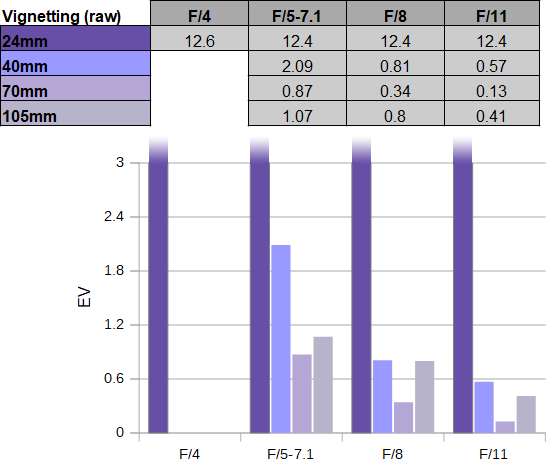 Here's what it looks like:
Here's what it looks like:
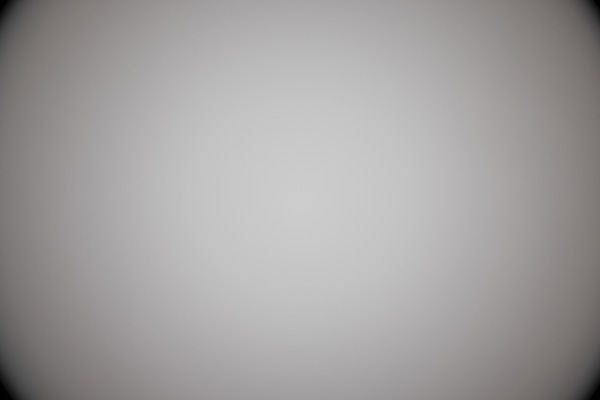 However, in all fairness, Canon doesn't even allow disabling distortion correction for in-camera JPEGs. If we follow this guidance, the results are actually more "normal". There's still some very heavy vignetting at 24mm at f/4 but one stop down, it's quite acceptable actually.
However, in all fairness, Canon doesn't even allow disabling distortion correction for in-camera JPEGs. If we follow this guidance, the results are actually more "normal". There's still some very heavy vignetting at 24mm at f/4 but one stop down, it's quite acceptable actually.
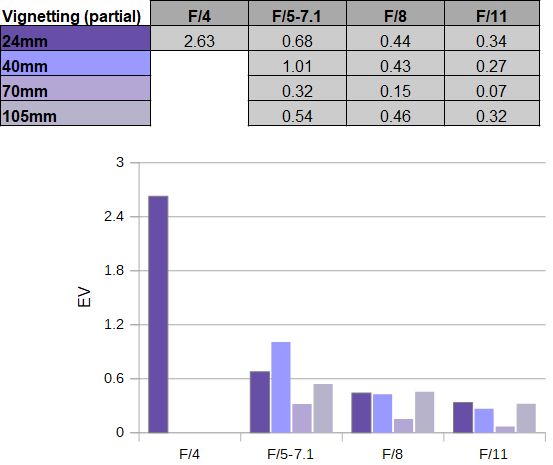 With full auto-correction, vignetting is nothing to worry about - except for the increased corner noise due to the required signal boost.
With full auto-correction, vignetting is nothing to worry about - except for the increased corner noise due to the required signal boost.
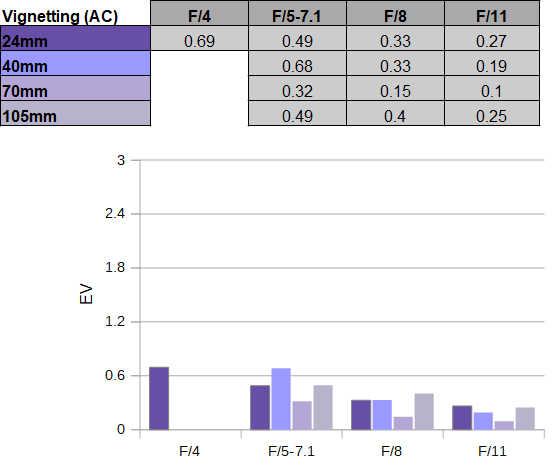
MTF (resolution)
Our MTF analysis is usually based on uncorrected RAW images. This is fine unless you have to deal with excessive image distortions ... more on this in the next chapter.
The Canon RF 24-105mm f/4-7.1 STM IS performs better than expected in our conventional test. While the figures aren't brilliant, they are actually fairly decent for such an affordable standard zoom lens with an expected weak spot at the 24mm setting again. The broader center resolution is generally very good to excellent whereas the borders are taking a hit. At "large apertures" they are still good whereas the corners are soft. Stopping down to f/8 produces the best results with acceptable corners. Longer focal lengths perform surprisingly well with no real weakness (nor strength).
The field curvature is very low. The centering quality of the tested sample was Ok.
Please note that the MTF results are not directly comparable across the different systems!
Below is a simplified summary of the formal findings. The chart shows line widths per picture height (LW/PH) which can be taken as a measure for sharpness.
If you want to know more about the MTF50 figures, you may check out the corresponding Imatest Explanations
 While the above is looking Ok, there is the mentioned caveat - the excessive distortion at 24mm. You will not use RAW images taken with this lens at 24mm and the distortion correction doesn't come free of charge. The price you pay is the stretching of the image and that's mostly done in the outer image field where the impact is worst. The MTF below shows the resolution with activated auto-correction. As you can see the broader center remains mostly intact with a negligible decrease in quality. The borders are soft and the corner quality is basically ... gone.
While the above is looking Ok, there is the mentioned caveat - the excessive distortion at 24mm. You will not use RAW images taken with this lens at 24mm and the distortion correction doesn't come free of charge. The price you pay is the stretching of the image and that's mostly done in the outer image field where the impact is worst. The MTF below shows the resolution with activated auto-correction. As you can see the broader center remains mostly intact with a negligible decrease in quality. The borders are soft and the corner quality is basically ... gone.
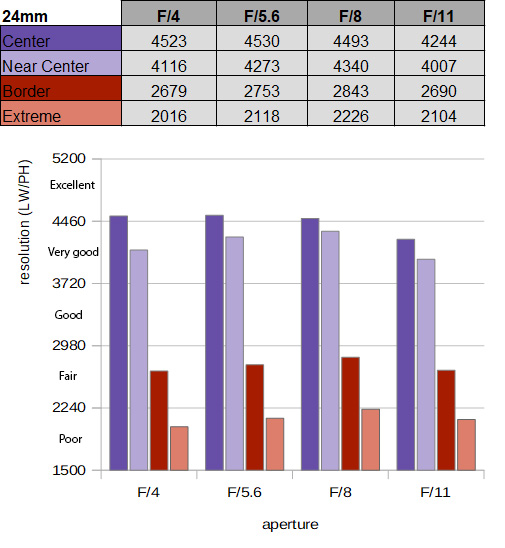 However, things are still not as obvious as they may seem. The above results are based on the R5 - thus on a 45mp sensor. If you purchased an R5 with this lens, you are nuts. In real life, this lens is used on entry to mid-level cameras with a resolution between 20-30mp. And this is putting much less stress on the lens quality. At 20mp (e.g. the EOS R6) you could mount a coke bottle and the results would still be mostly Ok (sort of). Below are the MTFs (auto-corrected) based on the 30mp sensor of the original EOS R. So as you can see, the results aren't QUITE as embarrassing as they are on the EOS R5. Even the corners are still fairly good. Longer focal lengths are perfectly fine on lower resolution cameras anyway.
However, things are still not as obvious as they may seem. The above results are based on the R5 - thus on a 45mp sensor. If you purchased an R5 with this lens, you are nuts. In real life, this lens is used on entry to mid-level cameras with a resolution between 20-30mp. And this is putting much less stress on the lens quality. At 20mp (e.g. the EOS R6) you could mount a coke bottle and the results would still be mostly Ok (sort of). Below are the MTFs (auto-corrected) based on the 30mp sensor of the original EOS R. So as you can see, the results aren't QUITE as embarrassing as they are on the EOS R5. Even the corners are still fairly good. Longer focal lengths are perfectly fine on lower resolution cameras anyway.
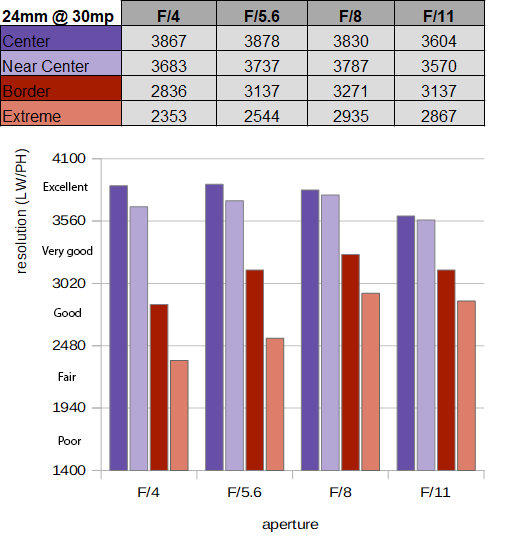
Chromatic Aberrations (CAs)
Lateral CAs (color shadows at the image borders) are about average and visible without auto-correction. They reach their peak at 40mm f/5 with an average pixel of ~2.6px at the image borders. Stopped own and at other focal lengths, they are relatively decent though.

Bokeh
Let's have a brief look at the bokeh. Just to point out the obvious - if you buy this lens with the intention of achieving a shallow depth-of-field, you are doing it wrong. We are talking about a lens with a max aperture of f/7.1 at 105mm after all. Of course, you can still produce some out-of-focus blur when using close focus distances but the lens is certainly not made for this purpose.
That being said, the rendering of out-focus-highlights is actually good with a pretty clean inner zone of the discs. They are also maintaining a circular shape in the image center even when stopped down to f/11.
 When looking at out-of-focus highlights across the image frame, things are also surprisingly fine. The circular shape is maintained across a broad part of the image field.
When looking at out-of-focus highlights across the image frame, things are also surprisingly fine. The circular shape is maintained across a broad part of the image field.
|